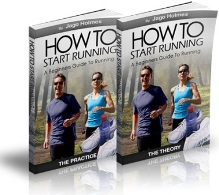Home | Blog | Contact Us | Order Page | About Us | Running For Beginners
|
||
How to Get Rid Of a Stitch When Running
What Is a Stitch?
There are a number of theories about what actually causes a stitch when running, but the 2 main thoughts behind the problem focus on the diaphragm going in to cramp. The diaphragm is a large muscle that sits between your lungs and abdominal muscles and is responsible for controlling breathing.
REASON #1
One reason for the cramping of the diaphragm is thought to be due to an inadequate supply of blood to the area. The movement of your legs when running increases the pressure on the abdominal muscles which can press against the diaphragm.
As you start to tire, your lungs need to work harder to take in and distribute oxygen, therefore they expand to a greater degree, which also presses down on the diaphragm. Both these factors cause a reduction in the blood flow to the area which leads to cramping.
REASON #2
Another reason is thought to be due to the increased load on the area due to the weight of the internal organs which attach to the diaphragm by way of ligaments. The most common side to feel a stitch is on the right. This is because the liver is attached on this side and it is the heaviest of all the organs.
The reason why beginners often suffer from stitches is that their abdominal muscles haven’t had the chance to develop enough strength to control the bouncing caused through running. This means that there is little support for the internal organs which pull excessively on the diaphragm.
A stitch when running can be made worse by eating a large meal too close to running and especially a fatty meal as fats take longer to digest, therefore staying in the stomach much longer.
How to Get Rid Of a Stitch When Running
Once you have a stitch, what is the best way to alleviate the symptoms?
Again there are a few theories that cover this, so here are the most effective ones you can use to try and solve the problem.
Your Pre Run Meal
This shouldn’t be eaten less than 2 hours before you run and should be mainly based on carbohydrates. Ideally a small meal which contains very little fat.
During your run
Unfortunately if you get a stitch when running, you’ll probably have to stop until the stitch subsides, which it should normally do after a few minutes.
Deep breathing may help. To do this, stop first and then take your arms above your head and slow down your rate of breathing, taking a series of longer, slower, deeper breaths.
Stopping to stretch can often help. To do this, raise both arms straight up above the head and the bend over slightly to each side still stretching your arms above. Do this for about a minute.
Slowing down your pace and changing your running style so you glide your feet over the ground instead of taking bounding steps can help as this minimises bounce and lessens the impact.
Slowing down your breathing rate and pressing your hand in to the side where you can feel the stitch often helps to relieve the symptoms. If you place your hand under the bottom rib and squeeze at the same time as bending forwards slightly, this usually helps to get rid of a stitch when running, because it reduces movement.
Using a back support or thick bandage around your waist can also prevent too much movement of the internal organs. This basically does the job that strong abdominal muscles normally do.
One final tip is to adjust your breathing pattern so that you breathe out when the foot of the pain free side hits the floor and then breathe in again when that same foot hits the floor once more. So if you have a stitch on the left of your stomach, you should breathe in and out whenever your right foot hits the ground.
Running in wintery or cold conditions can be very uncomfortable for the throat as it takes in the cold air, so if you do run in very cold weather, use a neck warmer or scarf to breathe through because this warms and filters the air a little more than without one.
Also, make sure you’re breathing in and out through your mouth when you're running. Breathe deeply from your belly, not your chest. Deep belly breathing allows you to take in more air.
If you'd like to learn more about how to get rid of a stitch when running and the best ways to start running, click here now - running for beginners to get hold of 'How To Start Running.'
| ||
All Rights Reserved © 2010 - 2011- New Image Fitness Ltd |
|
||||||||||
|
Privacy Policy | Articles
| Site Map | Affiliates | Terms and Conditions
|
Resources
| Blog


